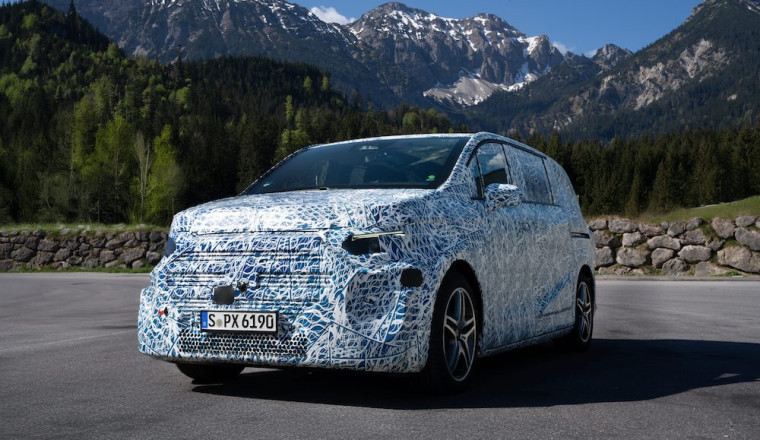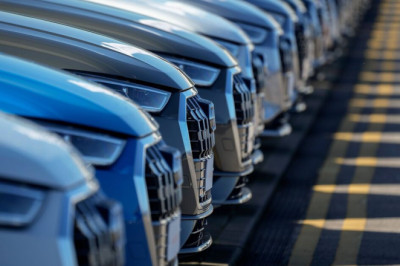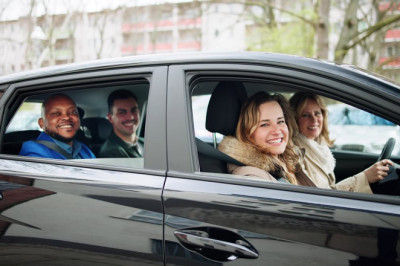
- From Stuttgart via the Alps to Rome-with just two short charging stops of 15 minutes under real‑life driving conditions
- Mercedes‑Benz VLE demonstrates the efficiency of the new Van Electric Architecture on the long-distance journey
- Rear-axle steering ensures easy and agile handling even in tight corners on Italian streets
The route profile: Demanding. On winding and steep pass roads across the Alps, long freeway sections, busy country roads and in narrow streets, the VLE demonstrated its suitability for everyday use, for example, for travel by families and leisure enthusiasts.
In focus: Suitability for everyday use with regard to the efficiency of the electric drivetrain as well as recuperation, thermal management and effects of the rear axle steering on vehicle handling.
The Mercedes‑Benz VLE was able to score high points here: The test vehicles easily covered the 1,090 ‑ kilometer route from Stuttgart to Rome in flowing traffic in around 13 hours. Charging took only two times for 15 minutes each time on the road. At the start in Stuttgart, the outside temperature was 11 degrees Celsius, while the arrival in Rome took place at 33 degrees. Comfort was not dispensed with, while the interior was air-conditioned to 22 degrees throughout the entire route.
The rear axle steering proved its worth in particular on winding pass roads and in the narrow streets of Italian cities. It will ensure agility and thus stress-free handling in everyday life.
"Our future MPVs have once again impressively demonstrated their suitability for everyday use on the long-distance route. With just two short charging stops from Stuttgart to the Alps to Rome - the Mercedes‑Benz VLE demonstrates impressive efficiency of the new Van Electric Architecture."
Dr. Andreas Zygan, Head of Development Mercedes-Benz Vans, Mercedes-Benz AG
Test drives for maturity level validation
Test drives such as the long-distance route from Stuttgart to Rome are part of a comprehensive program for testing the performance of the overall vehicle, which includes numerous climatic zones and route profiles. In addition to digital validation of the maturity level and tests in state-of-the-art test facilities at the Mercedes‑Benz Vans development campus in Stuttgart/Untertürkheim, the development vehicles are put through their paces in real operation on the road. In order to gain detailed insights into practicality and accelerate the development process to production maturity, the developers and engineers at Mercedes‑Benz carry out numerous development drives. For example, the first technology vehicles of the VLE drove from Stuttgart to the North Cape in Norway just over a year ago, and extensive cold testing was carried out in Sweden in the winter of 2025. This time, the VLE went over the Alps to the south to the Italian capital.
New Era
Starting 2026, Mercedes‑Benz will introduce its newly developed, modular and scalable Van Architecture – and sets the course for a completely new era. This architecture allows for a clear differentiation between privately positioned Grand Limousines and commercial transporters. As added value for customers is key for Mercedes‑Benz, future MPVs and transporters will suit perfectly the customers’ needs and demands, in terms of design, functions and usability.
Grand Limousines
The future models of privately positioned MPVs – also known as Grand Limousines – will be named as Mercedes‑Benz VLE and Mercedes‑Benz VLS. While the VLE with up to 8 seats will range from flexible vehicles for families and leisure active customers to exclusive VIP shuttles, the VLS will define a unique segment of its own that bestows true greatness to automotive luxury. For the first time, Mercedes-Benz will offer all-electric midsize luxury vehicles in the U.S., Canada and China (Grand Limousines).
Mercedes-Benz AG at a glance
Mercedes‑Benz AG is part of the Mercedes‑Benz Group AG with a total of around 175,000 employees worldwide and is responsible for the global business of Mercedes‑Benz Cars and Mercedes‑Benz Vans. Ola Källenius is Chairman of the Board of Management of Mercedes‑Benz AG. The company focuses on the development, production and sales of passenger cars, vans and vehicle-related services. Furthermore, the company aspires to be the leader in the fields of electric mobility and vehicle software. The product portfolio comprises the Mercedes‑Benz brand with Mercedes‑AMG, Mercedes‑Maybach and G‑Class with their all-electric models as well as products of the smart brand. Mercedes‑Benz AG is one of the world's largest manufacturers of high-end passenger cars. In 2024 it sold around 2,4 million passenger cars and vans. In its two business segments, Mercedes‑Benz AG is continually expanding its worldwide production network with more than 30 production sites on four continents, while gearing itself to meet the requirements of electric mobility. At the same time, the company is constructing and extending its global battery production network on three continents. As sustainability is the guiding principle of the Mercedes‑Benz strategy and for the company itself, this means creating lasting value for all stakeholders: for customers, employees, investors, business partners and society as a whole. The basis for this is the sustainable business strategy of the Mercedes‑Benz Group. The company thus takes responsibility for the economic, ecological and social effects of its business activities and looks at the entire value chain.














